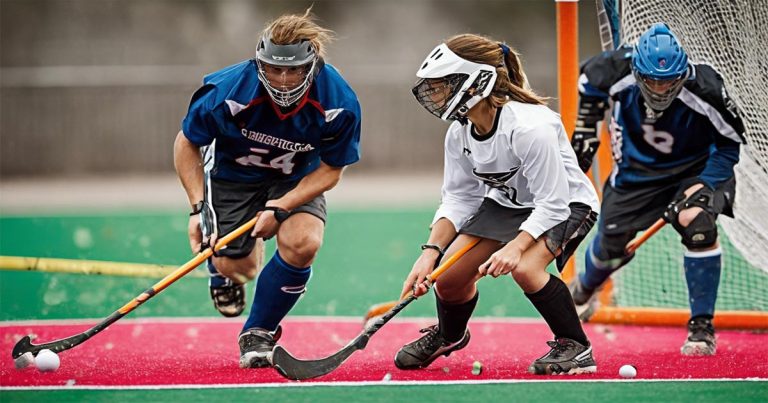Field hockey and lacrosse are popular team sports. They are often compared due to their similarities.
But what sets them apart? Field hockey and lacrosse have different origins, equipment, and playing styles. Field hockey is played on grass or turf with a small ball and curved sticks. Lacrosse uses a rubber ball and a stick with a net.
Each sport has unique rules and strategies. Understanding these differences can help you appreciate each game better. This blog post will explore the key distinctions between field hockey and lacrosse, shedding light on the characteristics that make each sport unique. Whether you are a player, fan, or just curious, this comparison will give you a clear understanding of what sets these two sports apart.
Origins And History
Field hockey and lacrosse are popular sports with rich histories. Their origins and development are fascinating. Understanding their roots reveals much about their unique characteristics.
Field Hockey Roots
Field hockey traces back to ancient civilizations. Early forms appeared in Egypt, Greece, and Persia. By the Middle Ages, Europe had adopted the game. Modern field hockey began in the 19th century. British schools and clubs standardized the rules. The first international match took place in 1895. This sport quickly spread across the British Empire. Today, it thrives worldwide, especially in Europe, Asia, and Oceania.
Lacrosse Beginnings
Lacrosse has deep Native American origins. Indigenous tribes played it for centuries. Known as “stickball,” it had spiritual significance. Early games could involve hundreds of players. European settlers first documented lacrosse in the 17th century. The modern version developed in Canada. In 1867, Montreal’s first club codified the rules. Lacrosse gained popularity in North America. Universities and clubs embraced it. Now, it enjoys a growing global presence.
Equipment Used
Understanding the equipment used in field hockey and lacrosse can help you see the key differences between these sports. Both require specific gear to ensure player safety and performance. Let’s delve into the details.
Field Hockey Gear
Field hockey players use a variety of equipment to play and stay safe. Here’s a breakdown of the essential gear:
- Hockey Stick: Made from wood or composite materials. The stick has a curved end used to hit the ball.
- Ball: Field hockey uses a small, hard ball, usually white, with a smooth surface.
- Shin Guards: Protect the lower legs from impacts and injuries.
- Mouth Guard: Used to protect teeth and gums.
- Cleats: Special shoes with studs to provide grip on grass or turf.
- Gloves: Worn to protect hands from blisters and injuries.
- Goalkeeper Gear: Includes helmet, pads, chest protector, and gloves. Goalies need extra protection.
Lacrosse Equipment
Lacrosse players also use specialized gear. Here’s what you need for lacrosse:
- Lacrosse Stick: Consists of a shaft and a head with a net. Used to catch, carry, and throw the ball.
- Ball: Lacrosse uses a rubber ball, usually bright-colored for visibility.
- Helmet: Essential for protecting the head. Includes a face mask.
- Shoulder Pads: Provide upper body protection from hits and falls.
- Elbow Pads: Protect the elbows from impacts and checks.
- Gloves: Protect hands and provide grip on the stick.
- Mouth Guard: Prevents dental injuries.
- Cleats: Designed to give traction on grass or turf.
- Goalie Gear: Includes additional padding, throat guard, chest protector, and gloves. Goalies require extra gear for safety.
Both sports have unique gear tailored to their specific needs. This ensures players stay safe and perform well on the field.
Rules And Regulations
Understanding the rules and regulations of field hockey and lacrosse is essential for players and fans alike. Each sport has its own set of guidelines that govern how the game is played. In this section, we’ll explore the key differences in rules and regulations between these two sports.
Field Hockey Rules
Field hockey is played with a small, hard ball and a curved stick. Each team has 11 players, including a goalie. The game consists of two halves, each lasting 35 minutes.
- Only the flat side of the stick can be used to hit the ball.
- Players cannot use their feet or any other body part to control the ball.
- Goals can only be scored from inside the striking circle.
- Field hockey has penalty corners and penalty strokes for certain fouls.
- Offside rules do not apply in field hockey.
Field hockey requires strict adherence to these rules to maintain fair play and safety.
Lacrosse Rules
Lacrosse is played with a rubber ball and a long-handled stick with a net called a crosse. Men’s lacrosse teams have 10 players, while women’s teams have 12 players. The game is divided into four quarters, each lasting 15 minutes.
- Players can use their sticks, feet, and bodies to control the ball.
- Goals can be scored from anywhere on the field.
- Checking is allowed in men’s lacrosse but is limited in women’s lacrosse.
- Offside rules apply, restricting the number of players on each side of the field.
- Lacrosse includes penalties like slashing and holding, resulting in time in the penalty box.
Lacrosse rules vary slightly between men’s and women’s games, but the core principles remain the same.

Credit: stxzlacrosse.com
Playing Field And Dimensions
Understanding the differences between field hockey and lacrosse involves many factors. One key aspect is the playing field and dimensions. Each sport has unique field requirements and layouts that impact gameplay.
Field Hockey Pitch
The field hockey pitch is a rectangular field. It measures 100 yards long and 60 yards wide. The field is divided into halves by a center line. There are 23-meter lines 23 meters from each end. These lines mark key areas for gameplay.
Each end of the field has a goal. The goal is 7 feet high and 12 feet wide. The shooting circle, also known as the ‘D’ or ‘circle’, is a key area in front of the goal. It measures 16 yards from the goal.
Lacrosse Field
The lacrosse field varies slightly for men’s and women’s games. Generally, it measures 110 yards long and 60 yards wide. The field has a midfield line that divides it into two equal halves. There is also a center circle where face-offs occur.
Each end of the field has a goal. The goal is 6 feet high and 6 feet wide. Around the goal, there is a crease with a radius of 9 feet. This area is crucial for goalies and attackers.
Here is a table summarizing the key differences:
| Aspect | Field Hockey | Lacrosse |
|---|---|---|
| Field Length | 100 yards | 110 yards |
| Field Width | 60 yards | 60 yards |
| Goal Dimensions | 7 feet high, 12 feet wide | 6 feet high, 6 feet wide |
| Key Area | Shooting circle (16 yards from goal) | Crease (9 feet radius) |
Understanding these differences helps players and fans appreciate the nuances of each sport. The unique field dimensions shape the strategies and skills needed in field hockey and lacrosse.
Player Roles And Positions
Understanding player roles and positions is crucial in both field hockey and lacrosse. Each sport has unique positions with specific responsibilities. Knowing these differences can help you appreciate each sport better. Let’s break down the positions in both sports.
Field Hockey Positions
In field hockey, there are three main categories of positions: forwards, midfielders, and defenders.
Forwards are responsible for scoring goals. They stay near the opponent’s goal and try to convert passes into goals. Midfielders play both offense and defense. They help forwards attack and support defenders. Defenders protect their goal. They stop the opposing team from scoring. Goalies are the last line of defense. They block shots and direct defenders.
Lacrosse Positions
In lacrosse, positions are broken down into attackers, midfielders, defenders, and goalies.
Attackers focus on scoring. They work near the opponent’s goal. Midfielders cover the entire field. They play both offense and defense. Defenders stay near their goal. They prevent the opposing team from scoring. Goalies guard the goal. They block shots and lead the defense.
Each position has a vital role. Understanding these roles can enhance your appreciation of each sport’s strategy.

Credit: www.thelacrossezone.com

Credit: www.esfexplore.org.hk
Frequently Asked Questions
What Are The Main Differences Between Field Hockey And Lacrosse?
Field hockey uses a ball and a curved stick. Lacrosse uses a rubber ball and a netted stick.
How Many Players Are On Each Team In Field Hockey And Lacrosse?
Field hockey teams have 11 players. Lacrosse teams have 10 players in men’s and 12 in women’s.
What Type Of Ball Is Used In Field Hockey And Lacrosse?
Field hockey uses a hard plastic ball. Lacrosse uses a small rubber ball.
Are The Playing Fields Different In Size For Field Hockey And Lacrosse?
Yes, field hockey fields are larger. Lacrosse fields are smaller and have different markings.
How Do Players Score Points In Field Hockey And Lacrosse?
In both sports, players score by getting the ball into the opponent’s goal.
What Protective Gear Is Needed For Field Hockey And Lacrosse?
Field hockey players wear shin guards and mouthguards. Lacrosse players use helmets, gloves, and sometimes shoulder pads.
Is Field Hockey Or Lacrosse More Physical?
Lacrosse is generally more physical due to body checks and stick checks.
How Long Is A Typical Game Of Field Hockey And Lacrosse?
Field hockey games last 60 minutes. Lacrosse games last 60 minutes for men’s and 50 minutes for women’s.
Do Field Hockey And Lacrosse Have Different Origins?
Yes, field hockey originated in Europe. Lacrosse originated with Native American tribes.
Conclusion
Field hockey and lacrosse have unique differences. Each sport offers distinct experiences. Field hockey uses a ball and sticks. Lacrosse uses a rubber ball and netted sticks. Both require teamwork and skill. Choosing between them depends on personal preference. Try both sports to discover your favorite.
Enjoy the excitement they bring. Happy playing!



